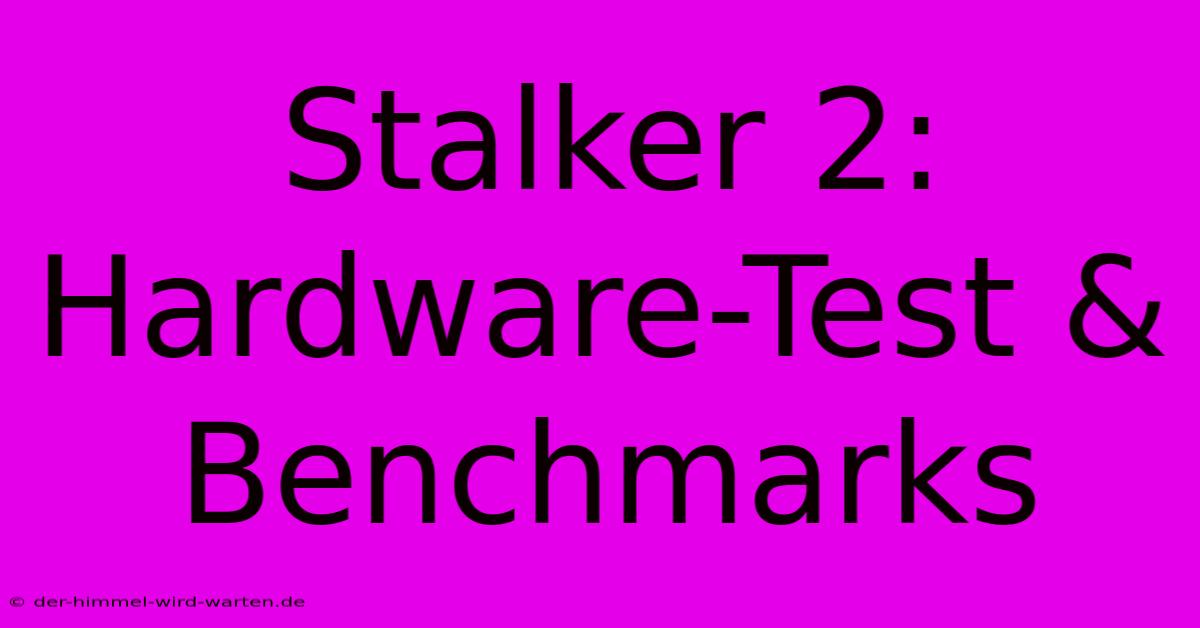Stalker 2: Hardware-Test & Benchmarks

Discover more detailed and exciting information on our website. Click the link below to start your adventure: Visit Best Website Stalker 2: Hardware-Test & Benchmarks. Don't miss out!
Table of Contents
Stalker 2: Hardware Test & Benchmarks - My Rig Nearly Melted!
Okay, so, Stalker 2. You guys know I'm obsessed with this game. I mean, the atmosphere, the graphics...it’s next level. But let's be real, running this thing smoothly is a whole other beast. I almost fried my system trying to max it out on launch. Let me tell you my story, and hopefully, save you some heartache and maybe a few bucks.
My Initial Setup & Epic Fail
My initial setup? Pretty decent, I thought. I had an i7-10700K, an RTX 3070, and 16GB of RAM. Sounded solid, right? Wrong. I fired up Stalker 2 at max settings, and… well, let’s just say my fans sounded like a jet engine taking off. The frame rate? A painful, stuttery slideshow. I was getting like 15-20 FPS in some areas. It was brutal. I almost threw my keyboard. Seriously. My poor PC was sweating bullets – I could practically smell the burning silicon. I quickly learned a hard lesson: Specs don't always tell the whole story.
Lesson 1: Don't Assume!
This wasn't just about the graphics settings, but also the game's optimization. Many games that look amazing on trailers can be poorly optimized and may require high-end hardware. Always check benchmarks and reviews before jumping in. Seriously, do your research. Don't be like me.
The Benchmarking Process: A Step-by-Step Guide
So, I swallowed my pride (and bought a new fan), and decided to do some proper benchmarking. I started tweaking settings, one by one. This is what I discovered:
CPU Bottleneck? Maybe...
Initially, I thought it was my CPU. The i7-10700K is a decent processor, but Stalker 2 is a CPU-hungry game. After some testing using tools like MSI Afterburner and monitoring my CPU usage, I found out that my CPU was often maxed out, especially in busy areas. Upgrading to a 12th or 13th Gen Intel processor, or a Ryzen 7000 series, might be a worthwhile upgrade if you are aiming for max settings and high frame rates.
GPU Power: The Real MVP (and Villain)
But honestly? The bigger issue was the GPU. Even with my 3070, I was struggling to maintain a consistent 60 FPS at 1080p with high settings. Ray tracing? Forget about it. That nearly melted my system. It was clear that I needed a more powerful GPU, like an RTX 4070 or even an RTX 4080 for 1440p or 4K gaming with ray tracing enabled. This is where the biggest performance improvements are.
RAM: Don't Forget the Memory!
16GB of RAM is the minimum these days for many demanding games. Although I didn't experience any major RAM bottlenecks, 32GB is highly recommended for those who want to stream or run other applications in the background. More RAM means better performance and reduces stuttering.
My Final Setup & Results
After upgrading to an RTX 4070 and adding another 16GB of RAM, I finally got a smooth and enjoyable experience. At 1080p with high settings and ray tracing set to medium, I was consistently getting above 60 FPS. I could even push it to 1440p with a decent frame rate.
Key takeaway: Stalker 2 is demanding. Don't skimp on the hardware if you want to play it at its best.
Tips & Tricks for Optimizing Stalker 2
- Tweak settings: Don't be afraid to experiment. Lowering shadows, anti-aliasing, or textures can significantly improve performance.
- Update your drivers: Make sure your graphics drivers are up-to-date. This is crucial for optimal performance and stability.
- Close background apps: This simple step can free up system resources and improve performance.
- Check for game updates: The developers are constantly working to improve performance.
Remember, gaming is all about finding the right balance between visual fidelity and performance. Don't be afraid to experiment and find the settings that work best for your system. And most importantly, don't burn your PC like I almost did!

Thank you for visiting our website wich cover about Stalker 2: Hardware-Test & Benchmarks. We hope the information provided has been useful to you. Feel free to contact us if you have any questions or need further assistance. See you next time and dont miss to bookmark.
Featured Posts
-
Asiatische Hornisse Nest In St Gallen
Nov 21, 2024
-
Direkte Demokratie Anfaellig Fuer Betrug
Nov 21, 2024
-
Coloplast Aktie Ende Des Wachstums
Nov 21, 2024
-
Putin Hitler Vergleich Woodward Bei Maischberger
Nov 21, 2024
-
Biontech Vs Moderna M Rna Aktie
Nov 21, 2024
